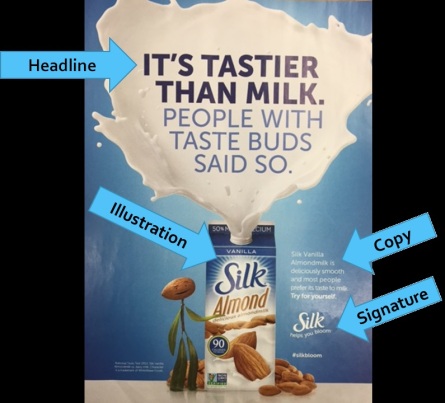“According to the Coherence Principle, you should avoid adding any material that does not support the instructional goal” (Clark & Mayer, 2008, pg. 151). It also suggests that e-lessons should avoid the following:
- Extraneous audio
- Extraneous graphics
- Extraneous words
An example of a successful attempt to apply the Coherence Principle would be to simply have a presentation slide with only what is necessary to teach the instructional goal. This could include a graphic and minimal text such as a headline, or labels of the graphic. An example presentation slide of this is shown below. There is no extraneous audio included and only necessary graphics and text are included. By eliminating extraneous audio, graphics, and words, channels will be able to process and apply what is being taught to the overall instructional goal, in this case learning the 4 parts of an advertising layout.

A bad example of applying the Coherence Principle can be found in Figure 8.2 on page 154 in e-Learning and the Science of Instruction. This is a poor example because it displays information about ammunition, while having background sounds with explosions. This audio is not necessary and is most likely distracting, violating the avoiding extraneous audio rule of this principle.
I have definitely seen this principle be violated and have most likely violated it in my own classroom! An example of a violation is when I had students create a PowerPoint project about themselves. When presenting the PowerPoint, a student used sound effects as the text was entering the slide. The sound they used was a typewriter for each word on the screen. Not only was this distracting to the audience and quite annoying, but it also took away from the oral presentation. In correlation with the cognitive theory of multimedia learning, “background sounds can overload or disrupt the cognitive system, so the narration and the extraneous sounds must compete for limited cognitive resources in the auditory channel” (Clark & Mayer, 2008, pg. 156). This would take away from the overall instructional goal of the presentation.
So far in this course, we have learned about the following multimedia principles:
- Multimedia: Include both words and graphics
- Contiguity: Place words near corresponding graphics
- Modality: Present words as speech rather than on-screen text
- Redundancy: Do not add on-screen text to narrated graphics
- Coherence: Avoid extraneous audio, text, and words
I believe that all of these principles work well with one another and the main goal is to achieve the instructional objective, while minimizing cognitive overload of channels. Learning about these principles has really made me think about past, current, and future presentations that I create. I know that I have violated some, if not all of these principles and in the future I plan to apply each to make my presentations more effective by minimizing the cognitive load for students.
Fundamental theories of psychology come into play when applying the Coherence Principle. By simplifying to only what is necessary to reach the instructional goal, channels will be able to process information more efficiently, allowing information to be better processed in the working memory.
What I like about this principle is that it supports that simplicity is a good thing. Many times as educators, we try to make these elaborate presentations that would actually be more effective if we followed that “less is sometimes better”. By eliminating extraneous audio, graphics, and words, students won’t experience cognitive overload.
Although the findings of this principle are backed up well by research, I appreciate that this textbook notices that there is still work to be done. There are challenges and unknowns about the Coherence Principle. One challenge in particular is determining if this principle applies to high-knowledge learners. “The challenge for instructional professionals is to stimulate interest without adding extraneous material that distracts from the cognitive objective of the lesson (Clark & Mayer, 2008, pg. 173). Further research would need to be completed in order to determine if there are ways to incorporate words/graphics while supporting the instructional goal and promoting interest. Now that I know about this principle, I plan to not only update my own lessons, but also teach these principles to my students for any presentations that they create.
References:
Clark, R. C. & Mayer, R. E. (2008). E-learning and the science of instruction, 2nd edition. Pfeiffer: San Francisco, CA.


